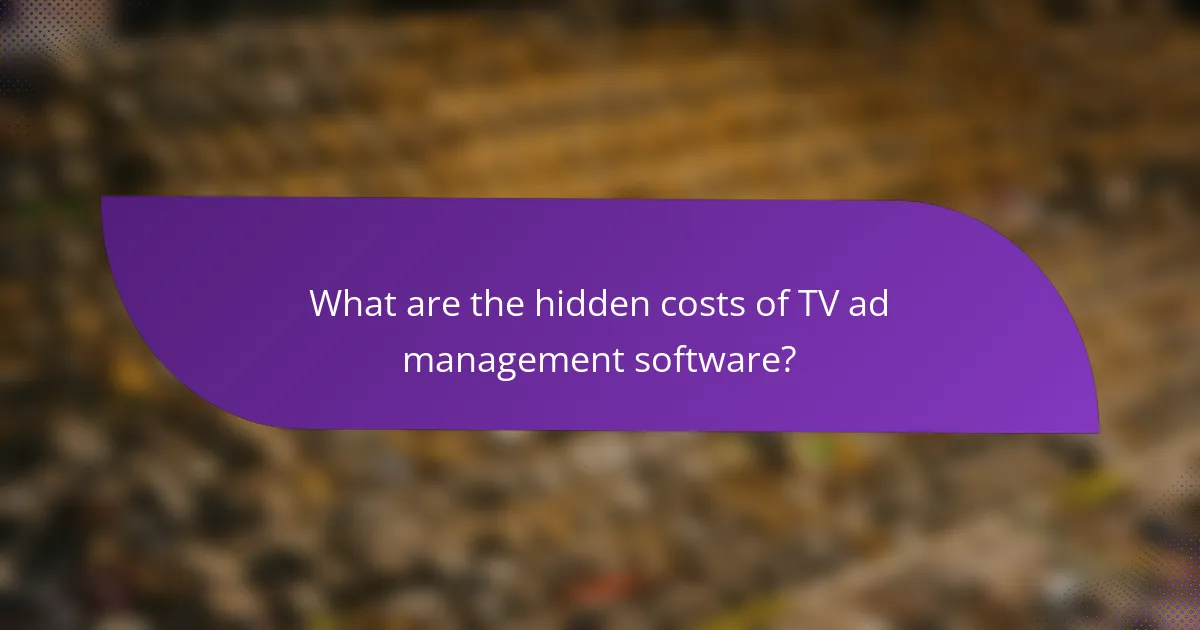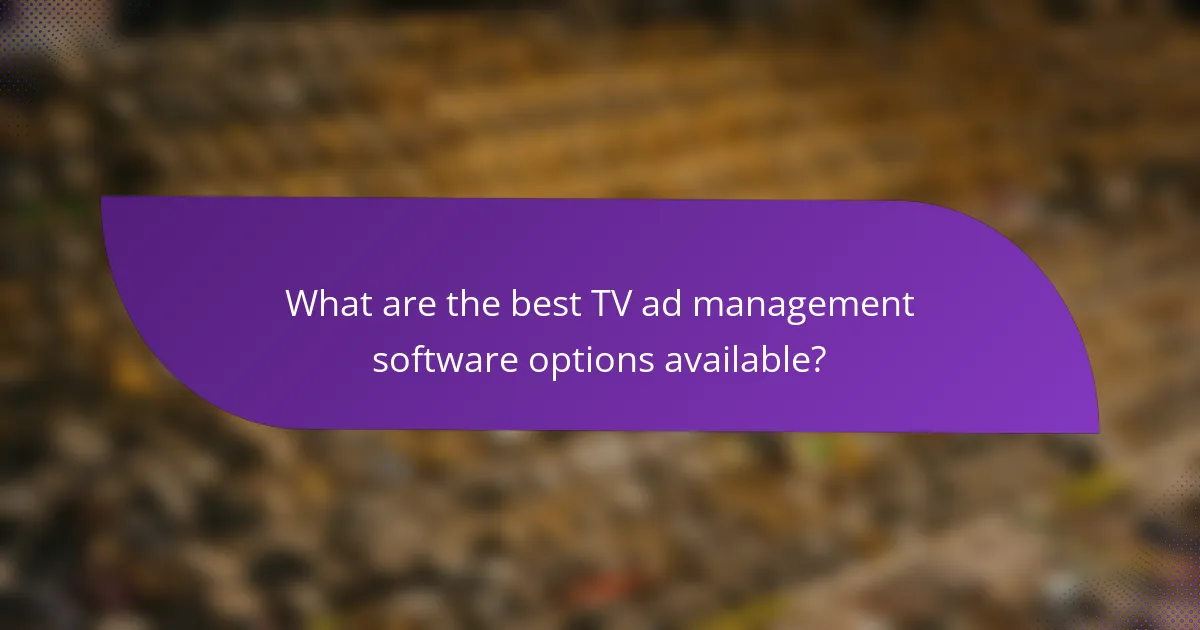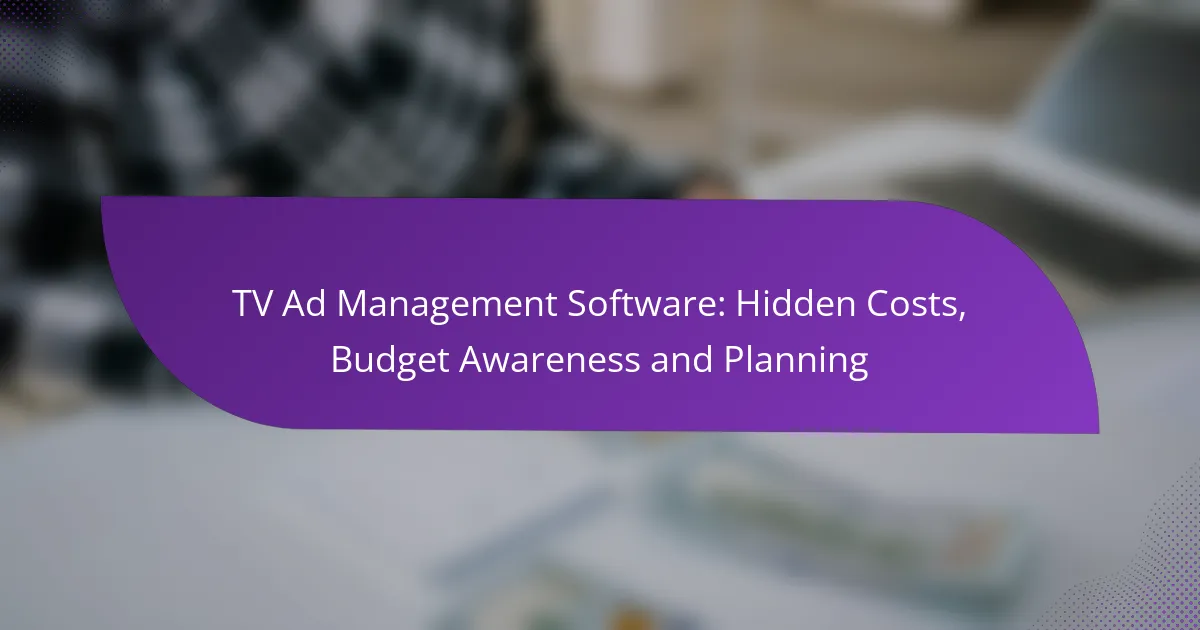Understanding the hidden costs of TV ad management software is crucial for effective budget planning. These expenses can arise from implementation and ongoing usage, often catching businesses off guard. By being aware of both direct and indirect costs, companies can make informed decisions and optimize their advertising strategies for better results.

What are the hidden costs of TV ad management software?
Hidden costs of TV ad management software can significantly impact your overall budget. These expenses often arise from various aspects of software implementation and usage that are not immediately apparent during the initial purchase decision.
Licensing fees
Licensing fees are a primary hidden cost associated with TV ad management software. These fees can vary widely based on the software’s features, the number of users, and the duration of the license. It’s essential to understand whether the fees are one-time payments or recurring charges, as this will affect your long-term budget.
Some software may offer tiered pricing models, where additional features come at a premium. Always review the licensing agreement carefully to avoid unexpected costs.
Training expenses
Training expenses can add up quickly when implementing new TV ad management software. While many providers offer basic training, advanced training sessions often come at an additional cost. Consider the learning curve for your team and budget for comprehensive training to ensure effective software use.
Investing in training can lead to better utilization of the software, ultimately saving time and reducing errors in ad management.
Integration costs
Integration costs refer to the expenses incurred when connecting the TV ad management software with existing systems. This may involve hiring external consultants or developers to ensure seamless integration, which can be costly. Assess the compatibility of the software with your current infrastructure before making a decision.
In some cases, integration may require additional software or tools, further increasing your overall expenditure. Always factor these potential costs into your budget planning.
Ongoing maintenance
Ongoing maintenance is another hidden cost that can catch businesses off guard. This includes regular updates, bug fixes, and technical support, which may not be included in the initial purchase price. Understanding the maintenance terms can help you avoid unexpected charges down the line.
Consider whether the software provider offers a maintenance package and what it covers. This can help you plan for these recurring expenses effectively.
Data storage fees
Data storage fees can accumulate based on the volume of data your TV ad management software handles. Many providers charge for data storage beyond a certain limit, which can lead to increased costs as your data needs grow. Be aware of the storage limits set by your software provider and plan accordingly.
Evaluate your data retention policies and consider whether you can optimize storage to minimize costs. Regularly reviewing your data usage can help you stay within budget.

How to budget for TV ad management software in the UK?
Budgeting for TV ad management software in the UK involves understanding both direct and indirect costs associated with the software. It’s essential to account for initial purchase prices, ongoing subscription fees, and any additional expenses that may arise during implementation and use.
Assessing total cost of ownership
The total cost of ownership (TCO) for TV ad management software includes not only the purchase price but also maintenance, support, and training costs. In the UK, this can range from a few hundred to several thousand pounds annually, depending on the software’s complexity and the size of your advertising campaigns.
Consider additional costs such as integration with existing systems, potential hardware upgrades, and the time spent on staff training. A detailed breakdown of these costs will help you understand the full financial commitment required.
Setting realistic budget limits
When setting budget limits for TV ad management software, consider both your current advertising spend and future growth projections. A practical approach is to allocate a percentage of your overall marketing budget, typically between 5-10%, to software costs.
Ensure that your budget allows for flexibility to accommodate unexpected expenses, such as software updates or additional features that may enhance your advertising efforts. Regularly review and adjust your budget based on actual spending and performance metrics.
Identifying potential ROI
Identifying potential return on investment (ROI) from TV ad management software requires evaluating how the software can improve campaign efficiency and effectiveness. Look for features that can streamline processes, enhance targeting, and provide detailed analytics to measure performance.
To estimate ROI, consider metrics such as increased audience reach, improved conversion rates, and overall sales growth attributed to your advertising efforts. A well-implemented software solution can lead to significant cost savings and revenue increases, making it a worthwhile investment in the long run.

What are the best TV ad management software options available?
The best TV ad management software options streamline the ad buying process, optimize campaigns, and provide analytics for better decision-making. Key players in this space include Adzooma, Marin Software, AdStage, and Google Ads Manager, each offering unique features and capabilities tailored to different advertising needs.
Adzooma
Adzooma is a user-friendly platform designed for small to medium-sized businesses looking to manage their TV ad campaigns effectively. It offers automation tools that help optimize ad spend and improve performance metrics without requiring extensive technical knowledge.
Key features include real-time analytics, budget tracking, and performance suggestions. Users can expect to see a reduction in manual tasks, allowing them to focus on strategy and creative aspects of their campaigns.
Marin Software
Marin Software is ideal for larger enterprises that require advanced analytics and cross-channel capabilities. This platform integrates TV advertising with digital channels, providing a comprehensive view of campaign performance.
With Marin, users can leverage data-driven insights to allocate budgets more effectively across various media. The software supports complex bidding strategies and offers detailed reporting, making it suitable for advertisers with significant budgets and diverse media strategies.
AdStage
AdStage focuses on simplifying the ad management process across multiple platforms, including TV. It allows users to create, manage, and analyze campaigns from a single dashboard, enhancing efficiency.
This software is particularly beneficial for agencies and marketers who need to report on performance across various channels. AdStage’s integration capabilities with other marketing tools help streamline workflows and improve collaboration among teams.
Google Ads Manager
Google Ads Manager is a robust platform that supports TV ad management alongside digital advertising. It is well-suited for advertisers familiar with Google’s ecosystem, offering powerful targeting and analytics features.
Users can set budgets, track performance, and adjust campaigns in real-time. The platform’s integration with Google Analytics provides deep insights into audience behavior, helping advertisers optimize their strategies effectively.

How to plan an effective TV ad budget?
To plan an effective TV ad budget, start by clearly defining your campaign goals and understanding the costs associated with production and airtime. This approach ensures that your spending aligns with your marketing objectives and maximizes your return on investment.
Defining campaign objectives
Clearly defined campaign objectives are essential for effective budgeting. Determine what you want to achieve, whether it’s brand awareness, lead generation, or sales conversion. Specific goals help in estimating the necessary budget and measuring success.
For example, if your objective is to increase brand awareness, you might allocate a larger portion of your budget to high-reach channels during peak viewing times. Conversely, for direct response campaigns, consider targeting specific demographics with tailored messaging.
Allocating resources wisely
Resource allocation involves distributing your budget across various components of the campaign, including production, media buying, and creative development. Prioritize spending based on the potential impact of each element on your overall objectives.
A common strategy is to allocate around 70% of your budget to media buying, 20% to production, and 10% to testing and optimization. Adjust these percentages based on your campaign’s specific needs and market conditions.
Monitoring performance metrics
Monitoring performance metrics is crucial for assessing the effectiveness of your TV ad campaign. Key metrics to track include reach, frequency, engagement, and conversion rates. These indicators help you understand how well your ad is performing against your objectives.
Utilize tools and analytics to gather data on viewer response and adjust your strategy accordingly. For instance, if a particular ad placement is underperforming, consider reallocating funds to more successful slots to enhance overall campaign performance.

What are the key features to look for in TV ad management software?
Key features to consider in TV ad management software include real-time analytics, budget tracking tools, integration capabilities, and a user-friendly interface. These elements help streamline ad campaigns, optimize spending, and enhance overall effectiveness.
Real-time analytics
Real-time analytics provide immediate insights into ad performance, allowing advertisers to make quick adjustments. Look for software that offers metrics such as viewership numbers, engagement rates, and demographic breakdowns.
Effective real-time analytics can help identify which ads resonate with audiences, enabling you to allocate resources more efficiently. Choose a platform that visualizes data clearly, making it easy to interpret and act upon.
Budget tracking tools
Budget tracking tools are essential for managing ad spend effectively. These features should allow you to set budgets, monitor expenditures, and compare projected costs against actual spending.
Consider software that provides alerts for budget overruns and offers insights into cost-per-impression or cost-per-acquisition. This will help you stay within financial limits while maximizing ad reach.
Integration capabilities
Integration capabilities ensure that your TV ad management software can work seamlessly with other marketing tools and platforms. Look for software that connects with CRM systems, social media, and analytics platforms to create a cohesive marketing strategy.
Effective integration can streamline workflows and enhance data sharing, allowing for more comprehensive campaign analysis. Check for APIs or built-in connectors that simplify these integrations.
User-friendly interface
A user-friendly interface is crucial for ensuring that all team members can navigate the software easily. Look for intuitive design elements, clear navigation, and accessible support resources.
Software that prioritizes user experience can reduce training time and improve adoption rates among staff. Consider platforms that offer customizable dashboards to suit different user needs and preferences.
